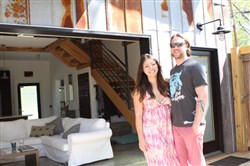VOL. 38 | NO. 16 | Friday, April 18, 2014
Little houses, big demand: New generation of homebuyer decides bigger isn’t better
By Bill Lewis
With just half the floor space of a typical new house, Hana Crume’s East Nashville home is unusual. But it won’t be that way for long.
Home builders took note when potential buyers lined up to make competing offers on Crume’s 1420 Shelby Street house. She bought the 1,105-square-foot home the day it went on the market, but only after a bidding war.
Now Fiddlehead Developers, the partnership that built her house, is planning more tiny homes nearby, and builders are making plans for dozens more in West Nashville with as little as 850 square feet of living space.
“Being comfortable, but responsible, was important to us,” says Crume, who shares the two-bedroom, 1½-bath home with her boyfriend, Jake Elliott.
“I don’t know if this is a trend. I only hope people are paying attention to this type of development.”
Builders like Mike Kenner certainly are.
His company, MiKen Development, is preparing to launch a development of 60 homes ranging from 850 to 1,600 square feet on a 5.5 acre site at 1206 60th Avenue N. in West Nashville across from West Park.
Unlike Baby Boomers, the millennial generation is less interested in large houses in the suburbs.
They want smaller homes in the heart of the city, “not the big McMansion in Brentwood where you drive an hour and a-half to work.
Value systems are changing,” Kenner explains.
Floor plans and home sizes are evolving to keep up with modern lifestyles. There’s no reason to build-in space for a master bedroom sitting area because that’s not where millennials are spending their time. The same is true of dining rooms.

Hana Crume and fiance Jake Elliott near the back deck of their East Nashville home.
-- Michelle Morrow | Nashville Ledger“They want to walk out the door and see their friends at restaurants and bars, not entertain in a formal dining room,” Kenner says.
Smaller houses have another advantage. They have prices that put ownership within reach of young buyers. Kenner expects prices in his small-home development to range from $199,000 to $350,000.
That’s more than the median price of houses throughout the Nashville region, which was $195,000 in March, according to the Greater Nashville Association of Realtors.
But it’s well below the price of most new construction inside the city, especially in popular neighborhoods like the Nations, next door to Kenner’s development, Sylvan Park or East Nashville.
Builder Jeff Estepp discovered the demand for small houses when he built a 750-square-foot home in the Nations. He intended to use it as a rental property but decided to put a for sale sign in the yard to see what would happen.
“Forty-eight hours later we had a contract,” Estepp says.
Small doesn’t have to mean cramped. Estepp’s house has 10-foot ceilings and a closet designed to double as a home office.
“We were able to put a built-in desk space in there,” he adds.
Another home built by Estepp has 1,050 square feet, but repeating that success is difficult.
Lot prices in the city’s most popular neighborhoods are soaring. Developers have to build larger houses in order to make a profit.
“I’d love to build as many as I can. I know there’s a huge demand,” he says.
Zac Thomas’ company, Woodland Street Partners, has plans for a neighborhood of several dozen homes in East Nashville ranging from 900 to 1,400 square feet.
He expects prices to be in the high $100,000s to the $200,000s.
“It protects economic diversity” in a neighborhood, he says. “Everything doesn’t have to be twice as expensive as it was.”
Homes in the neighborhood will have sustainable features including high-performance insulation and geothermal heating and cooling, adds Thomas.
In a sense, small homes could take Nashville’s neighborhoods back to the future, says Kenner.
Following World War II, small “Eisenhower houses” – about 850 square feet each – were popular in neighborhoods like Sylvan Heights.
“It was a trend in the 1950s,” he says.
Fiddlehead Developers, the partnership that built Hana Crume’s house, thinks small homes could be a trend again.
The group plans to build three more houses nearby with footprints ranging from 1,100 to 1,300 square feet, says Jeff Middlebrooks.
“Our plan is to push the envelope,” he says.
Fiddlehead’s partners include Middlebrooks, an energy consultant who operates Nashville Home Energy Solutions; builder Ryan Nichols of Green Home; and designers Rachel and Edward Martin of (n) habit.
Crume’s house was built with salvaged and reused materials and is expected to achieve an environmental sustainability certification of LEED Platinum.
The siding is 40-year-old tin roofing and burnt wood – a method of preserving the wood.
Handrails are fashioned from old iron and steel pipes.
The home has a southern exposure to maximize natural lighting.
A standing seam metal roof that reflects heat and Low-e windows help keep it cool even in direct sunlight. Indoor lights are efficient LEDs.
Other features include an on-demand water heating system and Energy Star appliances.
A rain garden conserves water.
The home’s most unusual feature may be the insulated glass living room wall, which rolls up and out of the way like a garage door.
Suddenly, the entire room becomes outdoor living space.
“It doubles our living space,” Crume says. “And when it’s down it works as a big window.”
“It’s nice to take up only the space that we need,” she says of her home. It’s plenty big enough.”